Symbols of Visual Objects
The art form of Chinese folk art is the visual image of the objects in the 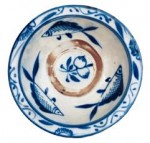 universe, according to the original Chinese philosophy.
universe, according to the original Chinese philosophy.
In primitive society, human was on the weak side in the struggle against natural disasters. Animals with superman capability became supernatural or totem animals in the eyes of humans, for example, polygenetic animals like fish, toad and frog were regarded as female totem symbols from mother’s body of earth and water; animals that were difficult to conquer such as snake, tiger, ox, boar, bear, or with special capability such as flying birds and butterflies; or that ran fast on mountain peaks and precipices like antelope; were male totem symbols, same as the sky and the sun. Over the course of several thousand years, these symbols have been, and still are, used by people of various national background and geographical areas in their respective regional folk art.
In the prairie areas of northern China, the deer totem symbol worshipped by the people in remote antiquity is still a symbol in today’s folk art of the prairie culture; and the pig and the dragon totem from Hongshan culture originated in primitive society in Liaohe basin are still the upper stream 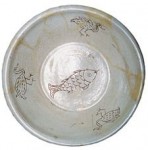 Yangtze River. Regional totem symbols still prevail in today’s folk art.
Yangtze River. Regional totem symbols still prevail in today’s folk art.
In ancient China, people connected natural animals with the sky and earth, and with the theory of yin-yang. Animals in the yang group symbolized the sky and the sun. The unification of “yang” animal from the sky with “yin” animals of earth meant a connection of the sky and earth, or the unity of yinyang. Among Chinese totem animals and legendary animals, the tiger, the ox, the goat, the bird, the bear, the boar, the dog and the cock were of the sky and yang group; the dragon, the snake, the turtle, the fish and the frog were yin group and symbols of earth and water. The dragon, with his head on earth but mating in heaven, was a totem of both worlds (Dragon was originally earth and water animal, but later went to heaven to become the king, and phoenix, an animal in heaven was the queen.) This is rather unique. For example, dragon, being an earth and water totem symbol, later became a cultural symbol of the entire nation in the confluence of multiple national cultures. People integrated the dragon into their own totem animal which turned into the dragon with a boar head in Liaohe basin; or the dragon with a tiger head in the middle-upper stream of the Yellow River; the dragon with a bird head in middle-lower stream of the Yellow River and the Yangtze River; and the dragon with an ox head in middle-upper stream of the Yangtze River. It is also quite common to see “fish with a tiger head” or “fish with a cock head” in Chinese folk art. When two animals are combined into one, it was a cultural symbol that  heaven and earth connect, male and female mate. Other example like “cock holding a fish in the mouth” and “bird holding a fish in the mouth” also implied the connection of heaven and earth, yin and yang. It was a cultural code originated in the communal philosophy in primitive society.
heaven and earth connect, male and female mate. Other example like “cock holding a fish in the mouth” and “bird holding a fish in the mouth” also implied the connection of heaven and earth, yin and yang. It was a cultural code originated in the communal philosophy in primitive society.
Another symbol in Chinese folk art was a pair of animals on each side of the tree of life. This was a common design in silk weaving pictures from the Silk Road. In the culture of primitive society, a tree meant the tree of life, and it was guarded by the two animals, one on each side. However, when such totem was introduced to China, the two animals from the opposite side were given a philosophical nature as yin and yang, male and female. The totem symbols in Chinese primitive society were the paired fish, toads, snakes, tigers, deer and birds, all paired up as male and female, yin and yang, or animals of earth and the sky.
The planetary paired fish, toads, deer, goats, and birds revolving in the sky in primitive and folk art are philosophical symbols which unified in the theory of yinyang and perpetual life. Such philosophical and cultural implications were revealed in folk art designs in which two totem animals facing each other, with a symbolic sun up above in the middle, such as “Two dragons playing with a ball,” “Two phoenixes facing toward the sun,” or with a symbol of life in the middle in “The tree of life and a pair of deer,” “The tree of life with a pair of goats,” or with “A pair of monkey” etc.
The pattern of two animals revolving in opposite directions implies the revolution of the universe and continuation of life. Common patterns are rotating fish in pairs, triples or quadruples; or rotating birds. Sometimes, the fish or the revolving fish are painted on the bottom or the lower part of a dish, a metaphor for mother’s body of the universe, to symbolize the revolution of earth; or on the upper portion or the edge of the utensils, to symbolize the revolution of the sky.
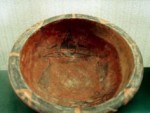 Among the legendary animals, proliferous animal was regarded as god of propagation, such as rat. As a folk proverb goes, rat being “the smallest in size, but the biggest among the twelve animals of earthly branches.”Cultural symbols implying proliferation are shown in “Rat eating pumpkin,” “Rat eating grape” and “Rat stealing oil” (oil container as mother’s body for propagation). Theme paper-cut and woodcut New Year picture “Rat marry off a daughter,” came from the legend that the rat, god of propagation, marries off a daughter every year on “The Human Day,” the 7th of first lunar month. Rabbit, also proliferous, is another god of propagation in “Rabbit eating cabbage,”“Rabbit coiled by a snake,” an image of totem snake protecting and nurturing the newborns.
Among the legendary animals, proliferous animal was regarded as god of propagation, such as rat. As a folk proverb goes, rat being “the smallest in size, but the biggest among the twelve animals of earthly branches.”Cultural symbols implying proliferation are shown in “Rat eating pumpkin,” “Rat eating grape” and “Rat stealing oil” (oil container as mother’s body for propagation). Theme paper-cut and woodcut New Year picture “Rat marry off a daughter,” came from the legend that the rat, god of propagation, marries off a daughter every year on “The Human Day,” the 7th of first lunar month. Rabbit, also proliferous, is another god of propagation in “Rabbit eating cabbage,”“Rabbit coiled by a snake,” an image of totem snake protecting and nurturing the newborns.
Insects with arms and legs spreading out from the center body are visual images of the sun in Chinese folk art works, such as crab, spider, scorpion, beetle, centipede, etc. They were originally symbols of the sun in ancient Egypt by the Neil and ancient Babylon River, and made its way to China via the Silk Road as early as primitive time. In west China along the Silk Road, eastern Gansu and central Shaanxi plain area, every year on the lunar Dragon Boat Festival, people still wear these animal figures on their vests, tan tops and hand bags as talismans, or symbols of patron saint. People call them five poisonous creatures nowadays, but they were actually old time legendary animals regarded as the sun god. The “Five poisonous creatures” are not supposed to get on body wear; however, it is acceptable to wear them in the chest or on the back for safeguard. One of the toughest two festivals for Chinese to survive against natural environment is, for one, the Dragon Boat Festival (Late June in the Gregorian calendar), the longest day in a year and in the dead heat of summer, with pestilence running rampant, threatening human lives. To invite these little sun animals out and wear them as talismans is to use poison as an antidote against poison. The winter Solstice (late December in the Gregorian calendar) is the coldest day and longest night in a year, a time ghosts and spirits run around. It is custom to put out symbols of rooster, another sun god, and “Baby with coiled hair” with double coils and a rooster on each; or having roosters all over her body; to keep away ghosts and evil spirits. This is also originated in the primitive culture along the two Babylon rivers. In ancient times, it went west to Europe, and east to China. When mingled with Chinese culture, it became a symbol of the communal culture in Chinese folk art ever since.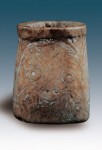
Human body as the celestial body – Not just totem and legendary animals are taken as symbols of the universe by Chinese folk art, human body is also an entity symbolizing integration of heaven and earth. Chinese emphasizes on the head. Likening human head to the universe, the top head is the sky; the two eyes are the moon and the sun; the chin is earth, and the mouth is the uterus of mother’s body, the source of life propagation; the nose is the tree of life stretching from heaven to earth. There were numerous such illustrations in the primitive culture. “A human face with a fish in the mouth” from Yangshao culture of Xi’an Banpo; the binary eyes in Hemudu culture; a mouth with protruding teeth from Hunan Gaomiao culture; were a few examples.
Appliance and utensils as the universe – the philosophical concept of “looking at oneself up close and other creatures from afar” in Chinese folk art perceives the objects protruding upward as a life code for yang, reaching out to the sky and the sun; and the hollow objects as symbol of yin, the uterus of mother’s body. Utensils like a bowl, a container, a bottle, a pot, and a dish are mother’s body of the universe. The center is the uterus; the opening is the round sky and the bottom is earth, forming a complete universal symbol with three key elements, the sky, earth and the people. Totem animals or earth and heaven animals of yin-yang nature are often painted on the center part where the uterus is, such as mating of two tigers; mating of two fish; or a pair of tigers with one head; a goat and a sheep sharing a common head; two dragons with one head; or a pair of dragons on a tiger head; implying connection between earth and the sky, yin-yang and perpetual life. From the porcelains of primitive society, to the bronze appliance of the Shang Zhou slave society; and the appliance and utensils in the imperial palaces of each dynasty or used by the ordinary people; were all based on the same concept. Every two-piece item that had an upper and lower part was interpreted as the combination of heaven and earth, the union of male and female. For example, a tea pot with a lid, the pot was mother’s body, earth and the lid was the sky and the sun; art work “Buckled bowl”, the upper lid is the sky and the bowl is earth. In the culture of primitive society, things that rotate were symbols of life moving in cycles of perpetuity. The earliest geometry symbol was a rotating Chinese letter Wan, drawn from the visual image of a manifold on a spinning wheel. In the world of nature, the sun is a luminous body. In Chinese folk art, plants with flower petals radiating from the center become a symbol of the sun, such as chrysanthemum, rose, peony and sun flower. The earliest plant used to symbolize the sun was on painted pottery from the 600-year-old Yangshao culture and Dawenkou culture.
After Buddhism was introduced to China, the image of lotus flower appeared in the primitive culture and folk art. Being a water plant, lotus was a symbol of water and earth. In folk art, peony was often a metaphor for yang or male; while lotus was for yin or female. However, it was interchangeable. “Phoenix playing around a peony” in which the peony meant to be a female; in another case, “Lotus in a vase,” the vase was mother’s body of the universe and lotus was the sun flower that could reach the sky.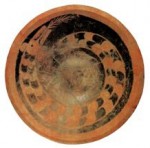
From the primitive culture to folk art, most of the images drawn from the visual plants were proliferous by nature, such as melon, fruits and vegetables, symbolizing mother’s body of the universe that gave life to humans and all living things on earth. First of such images was a gourd. A good number of gourd bottles were seen in Yangshao culture. They all had the same design with an upward nozzle open to the sky as mother’s body of the universe. Others images like pumpkin, grape, pear, cabbage, etc. were also symbols of propagation from proliferous mother’s body.